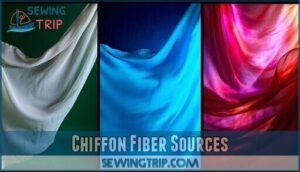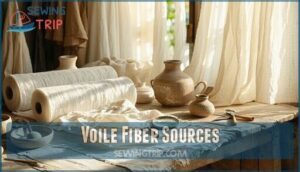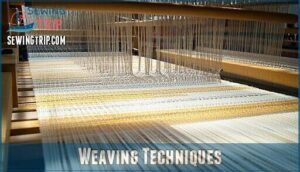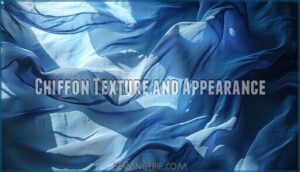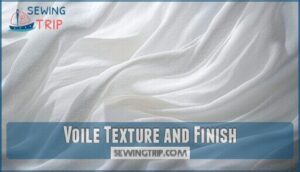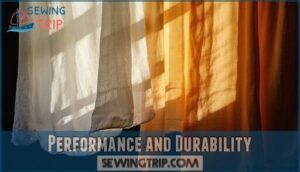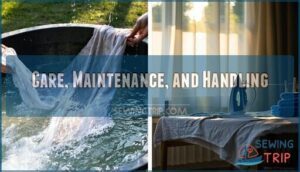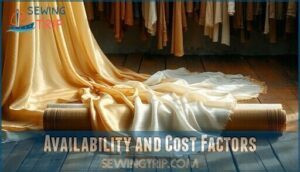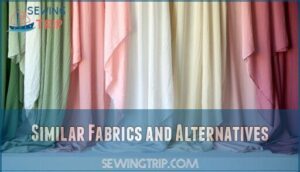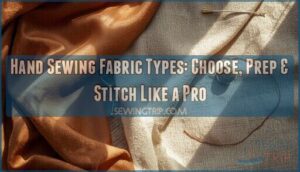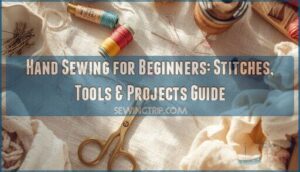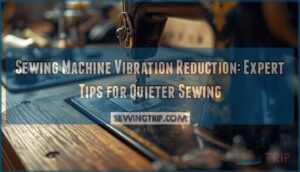This site is supported by our readers. We may earn a commission, at no cost to you, if you purchase through links.
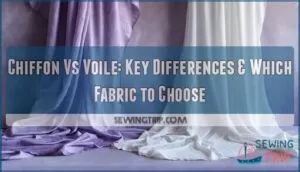
Chiffon feels rougher and drapes like liquid, making it perfect for evening wear and romantic designs. Voile maintains structured elegance with a controlled drape, ideal for custom blouses and professional garments.
Both offer lightweight transparency, but chiffon shimmers with fluid movement while voile holds its architectural shape. Think of chiffon as your dreamy dancing partner and voile as your reliable business colleague—each fulfills different purposes in fashion and home décor projects where specific texture and drape characteristics matter most.
Table Of Contents
- Key Takeaways
- Chiffon Vs Voile: Key Differences
- Fabric Composition and Weave
- Texture, Sheerness, and Drape
- Common Uses in Fashion
- Home Decor Applications
- Performance and Durability
- Care, Maintenance, and Handling
- Availability and Cost Factors
- Similar Fabrics and Alternatives
- Frequently Asked Questions (FAQs)
- Conclusion
Key Takeaways
- You’ll find chiffon uses alternating twisted yarns that create a rough, crinkled texture with fluid drape, while voile employs high-twist yarns in a plain weave for a smooth, crisp finish that holds its shape better.
- Chiffon works best for flowing evening wear and romantic designs where you need ethereal movement, while voile excels in structured blouses and professional garments that require clean lines and shape retention.
- You can expect to pay more for chiffon ($15-30/yard for silk, $3-8 for polyester) compared to voile ($6-12 for cotton, $4-10 for synthetic), with chiffon’s complex weaving process driving higher costs.
- Chiffon requires more delicate care with hand washing and gentle handling due to its fragile twisted fibers, while voile’s tighter weave makes it more durable for regular machine washing and everyday use.
Chiffon Vs Voile: Key Differences
You’ll quickly notice that chiffon and voile differ substantially in texture, weave structure, and drape characteristics, despite both being lightweight, sheer fabrics. While chiffon features a crinkled surface with alternating yarn twists that create its signature rough feel and fluid movement, voile uses a plain weave with high-twist yarns that produces a smooth, crisp finish and structured drape.
Despite both being lightweight and sheer, chiffon’s crinkled texture creates fluid movement while voile’s smooth weave produces structured drape
Overview of Chiffon
Chiffon fabric represents textile elegance through its distinctive plain weave construction. You’ll recognize chiffon by its sheer transparency and characteristic shimmering appearance that catches light beautifully. This lightweight material showcases notable fabric origins, evolving from silk exclusivity to synthetic accessibility, offering impressive material variety across fiber types.
| Characteristic | Description |
|---|---|
| Weave Structure | Plain weave with alternating S-twist and Z-twist yarns |
| Surface Texture | Slightly puckered with rough-to-touch feel |
| Transparency Level | Semi-transparent to fully sheer appearance |
| Fiber Options | Silk, polyester, nylon, rayon, cotton varieties |
Overview of Voile
While chiffon features a crinkled texture, voile presents a smooth, matte finish with a crisp drape. Voile’s origins trace to the French meaning "veil," usually crafted from cotton or polyester blends. This lightweight fabric offers structured support, unlike chiffon’s flowing movement. Due to its delicate nature, it’s best to use gentle washing practices.
The table below highlights voile’s distinct characteristics:
Main Distinguishing Factors
You’ll notice chiffon fabric’s distinctive surface texture and transparency level setting it apart from voile’s smoother finish. While both are lightweight fabrics, chiffon characteristics include a crinkled, puckered feel from twisted yarns, creating more fluid drape characteristics than voile’s structured appearance.
Fabric Composition and Weave
You’ll find that chiffon and voile differ substantially in their fiber composition and construction methods, which directly impacts their final characteristics.
Chiffon uses alternating s-twist and z-twist yarns in a plain weave, while voile employs high-twist yarns in a standard plain weave pattern, creating distinct textures and performance qualities.
Chiffon Fiber Sources
When you’re shopping for chiffon, you’ll discover it comes from diverse fiber sources that dramatically affect its feel and performance. Originally crafted from luxurious silk fibers, modern chiffon fabric materials now span synthetic options:
- Silk Chiffon – Premium natural fiber with outstanding drape
- Nylon Chiffon – Durable synthetic material introduced in 1938
- Polyester Chiffon – Affordable synthetic fibers with easy care
Rayon chiffon and cotton chiffon offer additional alternatives, though synthetic materials dominate today’s market.
Voile Fiber Sources
While chiffon offers versatility through multiple fiber options, voile takes a more traditional approach. Cotton Voile remains the highest quality, delivering breathability and softness that’s hard to beat. Polyester Voile provides durability and easier care, while Blended Voile combines the best of both worlds.
Sustainable Voile alternatives now include organic cotton and linen blends, appealing to eco-conscious consumers seeking sheer fabric options.
Identifying the specific fiber can be achieved through a fabric burn test.
Weaving Techniques
When you’re choosing between these fabrics, understanding the weaving process makes all the difference. Voile uses a plain weave with high thread count and standard loom types, while chiffon fabric weave employs alternating S- and Z-twist yarns through specialized shuttle motion.
The chiffon weaving process requires slower speeds to preserve delicate selvedge finishes and unique texture. Chiffon is known for its delicate texture, making it ideal for evening wear.
Texture, Sheerness, and Drape
When you’re comparing chiffon and voile, you’ll notice chiffon’s signature crinkled texture creates a rougher feel, while voile offers a smooth, crisp surface that’s almost silky to touch.
Chiffon flows with ethereal movement and maintains semi-transparency, whereas voile provides structured drape with better shape retention despite its sheerness.
Chiffon Texture and Appearance
When you run your fingers across chiffon fabric, you’ll immediately notice its distinctive puckered texture. This fabric roughness comes from alternating yarn twists that create a natural elasticity factor. Here’s what makes chiffon’s appearance unique:
- Sheer transparency allows light to filter through like fine mesh
- Shimmery surface reflects light beautifully from every angle
- Soft texture feels delicate yet slightly rough to touch
- Chiffon fabric weave creates visible crinkles throughout the material
- Chiffon fabric characteristics include natural stretch and fluid movement
Voile Texture and Finish
Voile fabric offers crisp texture through its plain weave construction with high-twist yarns, creating a matte finish that contrasts sharply with chiffon’s shimmery surface.
You’ll notice voile’s higher thread count delivers exceptional shape retention and structured drape compared to chiffon weave patterns. This fabric maintains its form while providing sheer coverage without chiffon characteristics like surface puckering.
Voile’s texture is influenced by weaving technique choices, impacting its overall feel and appearance.
Drape and Flow Comparison
When you’re choosing between these fabrics, chiffon delivers ethereal movement with exceptional fluidity factors. Its sheer, lightweight nature creates stunning silhouette creation and flowing garments that dance with every step.
Voile offers structured drape with controlled movement dynamics. Chiffon excels in layering effects for dramatic visual impact, while voile maintains crisp lines that won’t overwhelm your design.
Common Uses in Fashion
You’ll encounter distinct applications when choosing between chiffon and voile for your fashion projects, as each fabric caters to specific garment types based on its unique properties.
Chiffon excels in flowing evening wear and delicate overlays, while voile works best for structured blouses and crisp daywear that maintains its shape.
Chiffon for Evening Wear
Chiffon transforms evening wear with its ethereal quality and luxurious drape. You’ll find chiffon dresses flowing gracefully at galas, while chiffon skirts create stunning formal silhouettes.
Refined blouses paired with elegant overlays enhance any outfit. From delicate lingerie to luxurious scarves, chiffon’s sheer beauty makes every piece feel like wearable poetry for special occasions.
Voile for Structured Garments
Unlike chiffon fabric’s ethereal flow, voile excels when you need structured garments that maintain their shape. Voile Structure Types work perfectly for custom blouses and professional wear.
Its plain weave construction provides excellent Voile Interfacing Options for garment stability. The lightweight sheer fabric offers adaptable Voile Pattern Adaptations, while high-quality Voile Seam Finishes create clean, professional lines.
Usage in Accessories
Accessories showcase where these fabrics truly shine in your wardrobe. You’ll find chiffon dominates luxury items, while voile excels in structured pieces:
- Scarves and stoles: Chiffon scarves offer a luxurious drape and shimmer, while voile provides crisp, defined edges.
- Bridal veils: Chiffon creates ethereal, flowing movement; voile maintains a structured shape.
- Ribbon embellishments: Chiffon ribbons add romantic softness, while voile ribbons offer clean lines. Many vendors offer chiffon scarves stoles for various occasions.
Home Decor Applications
You’ll find both chiffon and voile serve distinct purposes in home decor. Chiffon’s flowing texture creates ethereal curtain panels that filter light beautifully, while voile’s crisp structure provides more controlled light diffusion and maintains clean lines.
Your choice depends on whether you want soft, romantic window treatments with chiffon’s billowy movement or structured, tailored panels with voile’s smooth finish.
Chiffon for Curtains and Drapes
Beyond fashion applications, you’ll discover chiffon’s potential transforms home spaces through elegant window treatments. Chiffon curtains offer outstanding light diffusion while maintaining privacy levels that suit various room needs. The fabric’s natural sheer quality creates an ethereal atmosphere, though lining options improve functionality when complete coverage matters. Shoppers can explore options for chiffon window coverings online.
| Feature | Sheer Chiffon | Lined Chiffon | Double Layer |
|---|---|---|---|
| Light Diffusion | Maximum | Moderate | Minimal |
| Privacy Levels | Low | High | Maximum |
| Color Impact | Vibrant | Muted | Rich |
| Cleaning Methods | Hand wash | Professional | Gentle cycle |
The fabric drapes well, creating flowing silhouettes that complement modern and traditional home decor styles perfectly.
Voile for Window Treatments
Voile weight makes it perfect for window treatments where you need privacy options without blocking natural light. This sheer fabric offers excellent light diffusion while maintaining visibility from inside. **Unlike heavier chiffon curtains, voile’s crisp structure holds its shape beautifully.
**
You’ll find color impact remains vibrant through voile’s smooth finish, and layering options work seamlessly with other window coverings for enhanced privacy control.
Decorative Uses
Both decorative fabric options offer distinct advantages for Event Decorations and Craft Projects. Consider these creative applications:
- Chiffon Uses: Elegant Gift Wrapping with flowing texture for special occasions
- Interior Accents: Voile window panels paired with chiffon overlays create layered depth
- Embellishment Options: Chiffon provides drape for Evening Wear displays and party backdrops
- Decorative fabric combinations: Mix textures for refined visual interest in any space
Performance and Durability
When you’re choosing between chiffon and voile, you’ll find that voile’s plain weave construction with high-twist yarns creates greater strength and longevity compared to chiffon’s delicate twisted fibers.
Both fabrics offer excellent breathability and comfort, but voile maintains its crisp structure better over time while chiffon’s ethereal drape comes with increased fragility and care requirements.
Strength and Longevity
When comparing durability, polyester chiffon outlasts silk varieties with tear resistance ranging from 10-30 Newtons. While chiffon fabric offers ethereal beauty, voile maintains color fastness and structural strength longer.
Voile’s tight weave integrity and high-twist construction provide exceptional fiber durability and pilling resistance.
To guarantee garments last, consider fabric selection based on its intended use. Your sheer fabric choice depends on prioritizing longevity over delicate drape.
Breathability and Comfort
Looking for fabric that feels good against your skin and works across seasons? Both chiffon and voile offer excellent breathability, but their comfort levels differ based on your needs.
Here’s how they compare for wearer comfort:
- Chiffon garments feel softer against sensitive skin due to their flowing drape
- Lightweight chiffon blouses provide better seasonal suitability for warm weather
- Voile fabrics offer more structure for active lifestyles without clinging
- Layering options work well with both, though chiffon’s sheer nature requires careful consideration
Clinging and Transparency
Chiffon fabric clings more to your body than voile, creating a softer silhouette impact that reveals curves subtly. Voile’s crisp structure maintains distance from skin, offering better coverage.
Both sheer fabrics demand careful undergarment choice, but chiffon’s semitransparency requires more strategic layering. Transparency levels vary, with silk chiffon being sheerer than polyester versions, affecting layering effects substantially.
Care, Maintenance, and Handling
Chiffon demands more delicate handling than voile, requiring hand washing or gentle machine cycles with cold water to prevent snags and maintain its flowing texture. Voile’s tighter weave makes it more durable for regular machine washing.
Both fabrics benefit from air drying and low-heat ironing with a pressing cloth to preserve their structure.
Washing and Drying Instructions
Both delicate fabrics demand careful washing techniques, but their care requirements differ slightly. Cold water preserves both fabrics’ integrity, and proper detergent choice prevents damage.
You should hand wash chiffon in cold water with gentle detergent to prevent snagging, while voile can handle a washing machine’s delicate cycle. You can find a suitable chiffon washing product online.
Air-dry both fabrics flat to maintain their shape and avoid heat-related shrinkage.
Ironing and Storage Tips
Between fabric care and hand-washed garments, temperature matters. Set your iron to silk or synthetic settings below 300°F. Use pressing cloths for humidity control and gentle detergent residue protection.
Proper folding techniques prevent creases, while mothballs provide moth protection. Store in breathable containers after cold water cleaning or dry cleaning for superior fabric preservation.
Preventing Damage
Beyond basic fabric care guide principles, you’ll want to master snag prevention by storing chiffon and voile separately from rough textures.
Hand washed items need immediate stain removal attention—blot, don’t rub. Professional cleaning works best for stubborn marks.
Store flat or rolled to prevent creasing. Learn simple repair techniques for minor tears before they worsen.
Availability and Cost Factors
You’ll find both chiffon and voile readily available at fabric stores and online retailers, though chiffon generally costs more due to its complex weaving process and premium fiber options like silk.
Voile offers better value for budget-conscious projects, while chiffon commands higher prices that reflect its luxury positioning in the textile market.
Chiffon Market Availability
Global suppliers deliver steady production volume through established retail distribution networks. You’ll find chiffon fabric readily available at Mood Fabrics, Etsy, and Fabric.com.
Market projections show growth reaching $6.9 billion by 2032, indicating strong future availability. Price trends remain stable as online retailers expand chiffon product access worldwide.
Checking remnant bins for savings can also yield affordable options.
Voile Market Availability
Supply chains make voile widely accessible through global suppliers and retail options. Key manufacturers include Arvind, ILIV, and Primary Voile, with India dominating exports at 47% market share.
This lightweight sheer fabric benefits from established weave manufacturing processes, ensuring consistent market trends favor availability. Growing demand for lightweight textiles strengthens distribution networks, making voile easier to source than chiffon across diverse retail channels.
Price Comparison
Your wallet will notice the difference between chiffon and voile. Silk chiffon costs $15-$30 per yard, while polyester chiffon runs substantially less. Material cost drives pricing, with silk commanding premium retail pricing. Brand influence affects affordability factors considerably. Production expenses vary based on synthetic fabrics versus natural silk chiffon fabric choices.
Here’s what you’ll usually spend:
- Silk chiffon: $15-30 per yard for luxury applications
- Polyester chiffon: $3-8 per yard for budget-friendly projects
- Cotton voile: $6-12 per yard for structured garments
- Synthetic voile: $4-10 per yard for home décor
- Designer brands: 2-3x standard pricing for premium options
Similar Fabrics and Alternatives
If you’re stuck between chiffon and voile, you’ll find several fabric alternatives that offer similar properties with their own unique advantages.
Organza provides chiffon’s sheerness with more structure, while georgette delivers comparable drape with a slightly heavier feel, and cotton lawn offers voile’s crispness in a more affordable option.
Fabrics Comparable to Chiffon
If you’re exploring lightweight alternatives to chiffon, several fabrics offer similar ethereal qualities. Georgette fabric provides comparable drape with slightly more structure. Crepe de Chine delivers silk’s luxury with smoother texture. Organza options offer crisp sheerness, while Charmeuse silk adds lustrous weight.
Synthetic fabrics like rayon and cotton blends create budget-friendly substitutes with chiffon’s flowing characteristics.
Fabrics Comparable to Voile
You’ll find several sheer woven fabric alternatives that share voile’s lightweight properties. These synthetic fabrics and natural options offer similar breathability with unique characteristics:
- Lawn fabric – Crisp cotton weave with higher thread count than standard voile
- Batiste cotton – Fine, plain-weave fabric smoother than chiffon fabric’s textured surface
- Gauze alternatives – Loose weave construction providing excellent airflow
- Muslin options – Adaptive cotton base with organdy characteristics when treated
Choosing The Right Fabric
Your fabric choice depends on project requirements and personal style preferences. Chiffon fabric offers lightweight softness and delicate appearance for flowing designs, while voile provides structured drape.
Consider budget constraints and ethical sourcing when selecting materials. This sheer woven fabric decision impacts your project’s final look and functionality substantially.
Frequently Asked Questions (FAQs)
Can chiffon and voile be blended together?
While they’re worlds apart in technical wizardry, you can absolutely blend chiffon and voile in the same design.
Combine chiffon overlays with voile underlays when you need stability without compromising the ethereal flow.
Which fabric wrinkles more easily during travel?
You’ll find chiffon wrinkles more easily than voile during travel. Chiffon’s delicate, crinkled weave structure makes it prone to creasing, while voile’s tighter plain weave resists wrinkles better.
Do both fabrics require special sewing techniques?
Yes, you’ll need specialized techniques for both. Use French seams or narrow hems to prevent fraying. Choose fine needles and lightweight thread.
Hand-baste before machine stitching to control their slippery nature.
Which is better for hot weather clothing?
Breathable bliss beats heavy heat! You’ll prefer voile’s crisp weave for sweltering summer days.
Its higher thread count provides better airflow than chiffon’s crinkled texture, keeping you cooler and more comfortable.
Can beginners work with these delicate fabrics?
Starting with delicate fabrics isn’t impossible, but you’ll face challenges. Both require gentle handling, sharp pins, and careful cutting.
Practice on scraps first, use stabilizers when needed, and expect some trial-and-error learning.
Conclusion
Picture a bride choosing between two ethereal fabrics for her wedding veil—chiffon’s romantic ripples catch light like morning mist, while voile’s crisp structure frames her face with architectural precision.
Understanding the chiffon vs voile difference helps you select the perfect fabric for your project. Chiffon’s twisted yarns create flowing movement ideal for evening gowns, while voile’s high-twist construction provides structured elegance for blouses and curtains.
Your choice depends on whether you need dreamy fluidity or controlled sophistication.
- https://sewport.com/fabrics-directory/chiffon-fabric
- https://blog.treasurie.com/what-is-voile/
- https://mytextilefabric.com/blogs/news/sheer-fabric-styles-voile-chiffon-and-organza-compared
- https://www.moodfabrics.com/blog/everything-you-need-to-know-about-chiffon-fabric/
- https://www.reddit.com/r/sewing/comments/1knjyi6/sheer_voile_vs_chiffon_vs_organza/

